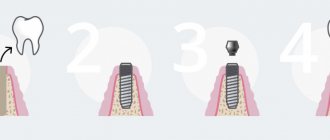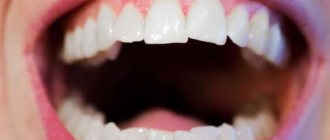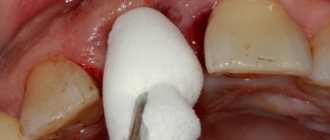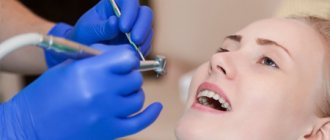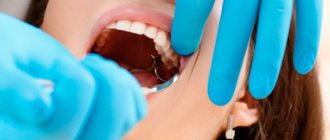Tooth extraction is a complex procedure that requires a certain recovery period. One of the stages of recovery is the installation of a turunda, which allows you to stop the bleeding that has begun and prevent the patient from developing wound inflammation and infection.
Turunda is a piece of sterile gauze or screw impregnated with iodoform. This is a special substance with antiseptic properties, which has a characteristic, recognizable taste and smell. The shade is rich yellow; after impregnation, turunda becomes light yellow. Instead of gauze, you can use cotton wool, which is also tightly twisted, soaked and placed in the cleaned cavity.
Basic goals:
- stopping bleeding;
- healing the condition, reducing the risk of tissue drying out;
- protection against pathogenic bacteria and infection of the open cavity;
- anti-inflammatory effect;
- removal of pus during the development of an abscess.
Installing a turunda is not always necessary. But if it is necessary to treat inflammatory processes or in case of severe bleeding, the use of a tampon is important to alleviate the condition and quickly heal the wound.
Suturing the gums after tooth extraction: when required
On the eve of a surgical operation, patients are often interested in whether it is necessary to apply sutures after removing a tooth - wisdom, canine, incisor. There are certain indications for gum suturing:
- Dental implantation. When choosing a one-stage tooth restoration protocol, the patient must undergo two surgical interventions at once. This is tooth extraction and immediate implantation. In order for the dental implant to take root in the bone tissue without any problems, the doctor will apply sutures and leave the implant in the tooth socket.
- Removing eights. Wisdom teeth are characterized by enlarged roots, an uncomfortable position in the jaw row, and difficulty in extraction. When third molars are removed, soft and bone tissues are severely damaged, heavy bleeding begins, and severe pain is possible. To reduce unpleasant consequences, the doctor places a hemostatic sponge in the hole and sutures the gums after tooth extraction.
Sutures are also indicated when there is a threat of severe bleeding, extraction of dystopic and impacted teeth. The manipulation is also performed at the patient’s personal request.
Why did you sew up the hole after tooth extraction?
If stitches were applied after wisdom tooth removal, this will only be beneficial. Repeated studies have proven that a sutured socket is:
- reducing the risk of infection and complications - by 90%;
- rapid stop of bleeding;
- preservation of the blood clot and natural healing of the wound;
- minimal pain after surgery;
- rapid fusion of tissues thanks to sutures.
Sutures are placed on the socket immediately after the removal operation. After which the doctor gives recommendations for accelerated healing and rapid normalization of the general condition.
Postoperative examination
Patients were examined clinically at 0, 1, 7, 14, 28, 60, and 90 days after surgery. The differences in treatment outcomes between patients treated with the two types of tampons are summarized below: 1. Patient discomfort during tamponade: While the material was in situ, patients were asked to record their perceived degree of discomfort on each side of the nose, using a visual analogue scale, ranging from 0 to 0. to 4, where 0 – no discomfort, 4 – the highest degree of discomfort. 2. Pain during removal: patients were asked to record their pain during removal of tampons on a separate scale, scored from 0 to 4, where 0 means no pain and 4 means very severe pain. 3. The degree of bleeding when removing the tampon: the attending physician himself assessed the degree of bleeding on a scale where no bleeding = 0, staining of the napkin = 1, discharge = 2, moderate bleeding = 3, severe bleeding = 4. Time required to stop bleeding after removal tampon, on a scale of 0 to 3, where 0 = up to 5 minutes, 1 = 5 to 10 minutes, 2 = 10 to 20 minutes, 3 = more than 20 minutes. Postoperative assessment of the healing process: presence of edema, formation of eschar, discharge and scars at 7, 14, 28, 60, and 90 days. The assessment was carried out using the validated Land-Kennedy scale.
Statistical analysis
Data were presented as mean ± standard error of the mean. SPSS software for Windows version 16.0 (SPSS Inc., Chicago, IL) was used for data analysis. To analyze qualitative variables, the χ2 test was used. A paired t test was used to analyze differences between groups. A P value < 0.05 was considered significant.
results
A total of 105 patients participated in the study, including 67 men and 38 women aged from 20 to 76 years, with an average age of 35.7 years. Of these, 100 patients visited the clinic for follow-up, in accordance with the clinical protocol. However, five patients were not assessed at follow-up visits due to protocol violations and early withdrawal from the study. There were no differences in the degree of nasal polyposis. The average Land-Mackay index for the side in which the hemostatic sponge was placed was 5.8; for the Merocel side, the value was 5.7 (P=0.654). Complete bilateral ethmoidectomy was performed in all cases. Average meatoantrostomy was performed in 96% of cases. Concomitant sphenoidotomy and frontal sinusotomy were performed in 50% and 45% of cases, respectively. There was no difference in the duration of surgery on either side. In terms of hemostatic properties, hemostatic gelatin sponge and Merocel were equally effective in stopping postoperative bleeding during tamponade. There were no postoperative complications, and all patients were discharged one day after surgery.
Degree of patient discomfort during tamponade and pain during removal Scores for the degree of discomfort felt during tamponade: 1.29 ± 0.20 for hemostatic gelatin sponge, and 2.19 ± 0.35 for Merocel. Tamponade with a hemostatic gelatin sponge was experienced with less discomfort than tamponade with Merocel (while the material was in situ) (P < 0.001). The degree of pain when removing the hemostatic gelatin sponge was estimated at 1.01±0.16, and when removing Merocel it was 2.37±0.19. The hemostatic gelatin sponge tampon caused less pain upon removal and the difference was statistically significant compared with Merocel (P < 0.001). Bleeding Score on Removal Scores for bleeding on tampon removal: 0.81±0.57 for hemostatic gelatin sponge, and 2.04±0.89 for Merocel. There was a significant difference in the rate of bleeding during pack removal between the hemostatic gelatin sponge and Merocel (P=0.007).
Time to stop bleeding after removing the tampon. If bleeding after removing the tampon did not require additional treatment other than the application of a gauze soaked in adrenaline solution. Points for assessing hemostasis time: for hemostatic gelatin sponge 0.57±0.25, for Merocel 1.62±0.40. Compared with Merocel, the hemostatic gelatin sponge required a significantly shorter time to control bleeding after pack removal (P=0.001).
Material cost
Hemostatic gelatin sponge costs 8,000 won (USD 7.1) per pack, Merocel 12,000 won (USD 10.7) per pack. The average total cost of hemostatic gelatin sponge for each operation was 13,200 won (11.7 US dollars), the cost of Merocel was 135,000 won (12.0 US dollars). There was no significant difference in the cost of the materials used, hemostatic gelatin sponge and Merocel. Endoscopic Land-Kennedy index Patients in both groups underwent postoperative endoscopic examination after 1 week, 2 weeks, 1 month, 2 months and 3 months. When comparing endoscopic postoperative evaluation scores, no statistically significant difference was observed between hemostatic gelatin sponge and Merocel (Table II).
Adverse Reactions and Complications No tampons were accidentally dropped, no patients experienced postoperative bleeding that would require tampon replacement to control, and no patients experienced significant bleeding after tampon removal. Consequently, both materials were shown to be equally effective in terms of stability and hemostatic properties.
Types of seams and suture materials
The patient’s further actions depend on what materials and suturing technique the surgeon used in dentistry. There are seams:
- Intermittent - stitches are applied separately, each secured with its own knot. Damage to one stitch does not affect the integrity of the others, allowing you to keep the hole closed.
- Continuous - all stitches are made with one suture thread and have a common knot. If one stitch is damaged, the entire seam comes apart.
Features of suture material:
- Absorbable threads are a sterile material of natural or synthetic composition, which after some time disintegrates into independent elements. During the healing process of the hole, the sutures securely fix the wound and then completely dissolve.
- Non-absorbable compounds are common synthetic threads used by dental surgeons in their work. These are polyester, nylon, silk, monofilament.
The material and features of suturing influence how the sutures are removed after the removal of a wisdom tooth or another unit.
Dental pin: what is it, its advantages and disadvantages
What is a dental post? This is a specialized dental structure that looks like a rod. It is installed into the tooth root as a support for a filling or crown. Installation of a pin is only possible if the tooth has a healthy root. As a rule, this design is used if the tooth is badly damaged and thin walls remain.
Advantages:
- reducing the load on the tooth root;
- the ability to restore the crown in just one visit to the dentist;
- ease of installation;
- high level of aesthetics of the future artificial tooth;
- relatively low cost.
Flaws:
- instability under heavy chewing loads;
- there is a risk of damage to the root walls;
- allergic reactions and the development of secondary caries are possible;
- metal rods can only be removed together with the tooth.
To successfully install the pin, the following conditions will need to be met:
- the length of the rod must be at least 2/3 of the length of the dental canal;
- the size of the rim of healthy tooth tissue is at least 2 mm;
- root canal treatment was carried out with high quality;
- the root canal was given a cylindrical or conical shape.
We sewed up the gum after tooth extraction: when to remove the sutures
Removal of sutures from the gums after tooth extraction is carried out 7-10 days after surgery. The doctor invites you to a follow-up appointment. When examining the patient’s oral cavity, the dentist notes the quality of wound healing and the general condition of the tissues in the area of the extracted tooth.
If healing goes well, the stitches will be removed on the same day.
How long does it take for sutures to dissolve after tooth extraction?
We sewed up the gum after tooth extraction - when the stitches dissolve depends on the material. There are many factors that determine the rate of natural destruction:
- composition - synthetic and natural;
- method of production of threads - what affects the breakdown of the composition;
- individual characteristics of the patient’s body - in particular the state of the immune system;
- the composition of saliva - destruction occurs under its influence.
There are approximate guidelines for when sutures dissolve after wisdom tooth removal, depending on the composition:
- 20-30 days - synthetic self-absorbing sutures after tooth extraction;
- 10-100 days - absorbable materials based on enzymes.
The most common questions about pins and answers to them
Is it always possible to get by with a pin?
Unfortunately no. In case of significant tooth decay, when there is a risk of further destruction of the coronal part, dental prosthetics are recommended.
How to care for your teeth after having a pin installed?
For two weeks, it is not advisable to eat too hard food and use toothpicks. When brushing your teeth, you need to be as careful as possible so as not to injure your gums.
Is there an alternative to a dental post?
Yes, you can install a stump tab instead. This is a microprosthesis, the lower part of which is fixed into the root canals, and the upper part serves as a supporting element for an artificial crown.
How to remove suture threads from a tooth socket
Many people associate the removal of sutures with unpleasant pain. Pain occurs only in people with a low pain threshold, increased sensitivity, or when there is inflammation in the tooth socket. Usually the patient experiences only discomfort.
Stages of removing suture material:
- treating the patient's oral cavity with an antiseptic;
- examination of the mucous membranes for hyperthermia, swelling, suppuration;
- the use of topical anesthesia to prevent even minimal pain;
- cutting the threads with a special dental instrument - the stitches are divided in half, especially in the case of an intermittent suture line;
- removing pieces of thread with tweezers;
- checking the density of the scar and the quality of wound healing.
Next, the patient will be asked to rinse his mouth with an antiseptic composition.
The first three days after the stitches are removed, stiffness of movements and discomfort when opening the mouth are possible.
Why do the sutures hurt after tooth extraction?
Unpleasant sensations accompany patients during the first hours after tooth extraction. Traumatic surgery requires some time for the body to recover. When the hole is sutured, the rehabilitation process goes faster, but complications also occur.
Alarming symptoms that require consultation with a doctor are as follows:
- bleeding - unexpectedly resumed or continues for more than a day;
- increasing pain - throbbing, radiating to the ear or neck, interfering with sleep and leading a normal lifestyle;
- growing swelling - of soft tissues in the oral cavity or even on the face from the side of the extracted tooth;
- redness and hyperthermia in the surgical area;
- saliva with blood - even several hours after removal;
- high temperature, weakness, general malaise.
Only the attending physician can understand what exactly is happening and what is the reason for feeling unwell. Therefore, at the first sign of discomfort, you need to call the clinic and make an appointment with a doctor.
